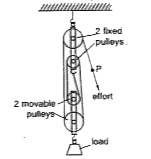The fulcrum of a lever of length 1 m is at its middle point. If the fulcrum is moved by 0.25 m towards the loads , how are efficiency and velocity ratio affected?
The correct Answer is:efficiency remains same, velocity ratio is increased 3 times
Topper's Solved these Questions
- MOMENT, TORQUE, EQUILIBRIUM OF BODIESBOOK - NN GHOSHCHAPTER - MOMENT, TORQUE, EQUILIBRIUM OF BODIESEXERCISE - Exercises
33 Videos
- LAWS OF MOTION, FREE BODY DIAGRAMBOOK - NN GHOSHCHAPTER - LAWS OF MOTION, FREE BODY DIAGRAMEXERCISE - Exercise (B)
34 Videos
- ROTATIONAL DYNAMICS, MOMENT OF INERTIABOOK - NN GHOSHCHAPTER - ROTATIONAL DYNAMICS, MOMENT OF INERTIAEXERCISE - Exercises
42 Videos
Similar Questions
A lever of length 9 cm has its load arm 5 cm long and the effort arm is 9 cm long. (a) to which class does it belong ?
(b) Draw a diagram of the lever showing the position of the fulcrum F and directions of both the load L and effort E. (c) what is the mechanical advantage and velocity ratio if the efficiency is 100%?
(d) What will be the mechanical advantage and velocity ratio if the efficiency becomes 50%?
View SolutionA crowbar is of 125 cm length. Its fulcrum is at a distance of 25 cm from the load. Find out the mechanical advantage.
View SolutionA crowbar of length 1 m is used to displace a body . Find its mechanical advantage, if the load arm is 0.5 m
View SolutionThe crow bar is a type of lever as shown in the figure. A crow bar of length 150 cm has its fulcrum at a distance of 25 cm from the load: Calculate mechanical advantage of this crow bar.

View SolutionA crowbar of length 0.75 m is used to dispace a body. Find its mechanical advantage, if the load arm is 0.25 m.
View SolutionIn the following figure :

How far does the point P have to move down in order to raise the load by 1 m?
View SolutionTwo object A and B are moving each with velocities 10 m/s. A is moving towards East and B is moving towards North from the same point as shown. Find velocity of A relative to B (→VAB)
View SolutionThe load arm and effort arm of a lever are 10 cm and 50 cm, respetively. The load and effort are applied on the opposite sides of the fulcrum. Identify the class of the lever. Find its mechanical advantage. If the effort applied is 10 N, how much load can be raised by it?
View SolutionA road roller of 200 kg wt slides on ground when pushed by a lever AB of length 1m, as shown in the figure. The force required to slide the roller acts at a distance of 5cm from the fulcrum. If the coefficient of friction between the roller and the ground is √2 find the effort required to move the roller. (Take g=10ms−2)

View SolutionIn Fig.1.35 a uniform bar of length l m is supported at its ends and loaded by a weight W kgf at its middle. In equilibrium find the reaction R1andR2 at the ends.

View Solution
